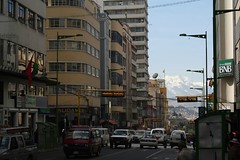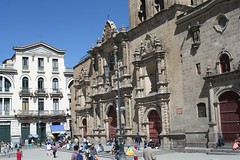
Click on pic to see slideshow
or here to access the set
I have never been to a city as geographically interesting as La Paz. Sure, I’ve seen pictures of it, but nothing prepared me for what I saw when I got here. To begin with, you read that the capital of Bolivia is at the bottom of a valley, but it isn’t a valley, it’s in fact a steep-walled canyon. The sprawling and dirt-poor suburb of El Alto sits on perfectly flat ground at the top of this canyon overlooking the real city below. If the residents of El Alto were to get pissed with their government they could walk to the edge of this ditch and throw rotten tomatoes at the presidential palace in Plaza Murillo…
The bottom of the canyon is the only flat ground available in town and it’s just enough for one large boulevard on whose sides the cross-streets rise sharply giving the city a terraced aspect. Besides all this, the bottom of this valley itself - the downtown - is “punctured” with smaller-scale ravines, so that between two main sections of the town one has to cross an elevated bridge which spans over a less-privileged neighborhood. “Nuestra Signora de La Paz”, by its old colonial name, is definitely an oddity among big cities and probably a tough nut to deal with for civil engineers.
As many guide-books say, the poor in this town enjoy better views than the rich and it is true: all but the steepest sides of the valley are covered with makeshift brick houses which can be usually reached just by stairs and sometimes by dirt alleys too steep for cars. God only knows how these multi-story shacks are erected, but the dominant theme seems to be “build until it’s habitable and don’t bother with the rest” – a principle which explains why the vast majority of houses outside the downtown, the colonial old town and the newer rich areas are never painted nor even covered in gypsum, and why the dominant color of this town, seen from any angle, is dark red: it’s all bare bricks.
Besides being the highest-altitude capital city in the world, La Paz could be famous for other things as well. If it were after me, I’d say it should be definitely known for its pastry shops: from the first day I noticed the many good-looking, clean cafes, having mouth-watering cakes and pastries on display. We didn’t try them all of course, but the ones we sampled were excellent and kept me going back for more.
Shopping could be another reason to visit this town: not only there are western-quality malls, boutiques and department stores in La Paz – for the more snobbish of the visitors who wouldn’t buy anything in a place that doesn’t have air conditioning and elevator music – but the city itself is one giant, hyper-stocked market. The abundance of street sellers isn’t matched by anything I’ve seen so far – in fact, one day, walking on one of the narrow streets that was covered in makeshift booths selling all kinds of clothing, we spent so long without meeting a cross-street or any traffic, that we thought we would end in El Alto accidentally… I can’t vouch for the quality of the merchandise, but it certainly isn’t expensive by our standards. What I don’t understand is how these people can make a living – when there are three hundred booths selling T-shirts, how many of them can make a sale before the end of the day?
Angela did some shopping of course, but I don’t think we went over $150 with all the things we got. We didn’t get anything we didn’t really need (mostly stuff for the upcoming visit to the very cold salt flats of Uyuni) or could carry in our backpacks.
One thing we learned the hard way is that the rates for hotel rooms have climbed to almost double since our Lonely Planet guide-book authors have researched the place in 2005. We didn’t like our hotel very much ($16 for a reasonably large room with a shared bathroom in an old colonial house) so we went searching for alternatives, but everything we found in the under-$20 range was either very dirty or downright creepy: if you can imagine a dimly lit, strangely smelling corridor with doors opening into bunker-like rooms with windows only to the inside, you got a good mental picture – would you stay there? I came to appreciate our hostel much more after our day of bargain-hunting...
After reading all the horror stories about tourists being tricked into following fake police officers into fake cabs to a fake police station and then forced at gunpoint to give away the PIN numbers for their bank cards and kept hostages until their accounts are emptied (gory details at http://www.katharinaandpeter.info) at the beginning we were understandably very cautions while walking on the street or getting into taxis. Needless to say we were not approached by any scammers (and neither are the large majority of tourists in Bolivia), and basic common sense would prevent any such unhappy event from happening – they cannot trick you without some degree of cooperation from you; thus knowing that the real police never asks to see one’s passport and even less likely their wallet and credit cards should be enough of a hint.
To sum up, La Paz is a “must see” in my South America ranking and definitely a town I would return to, despite the lack of impressive architecture or famous museums. It seems that I’m not the only one holding this opinion: the place has already been invaded by hordes of young Israelis…
Addendum for those with inside knowledge: white people, stop wearing Andean striped pants, you look like you just got out of jail!







No comments:
Post a Comment